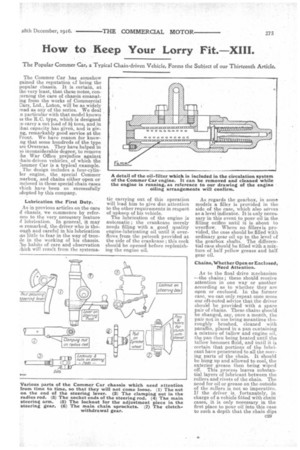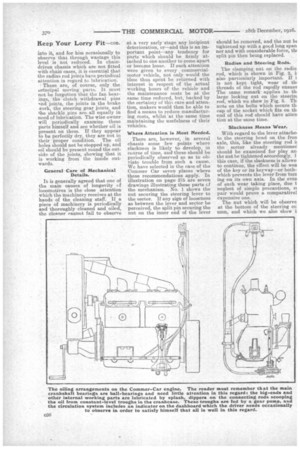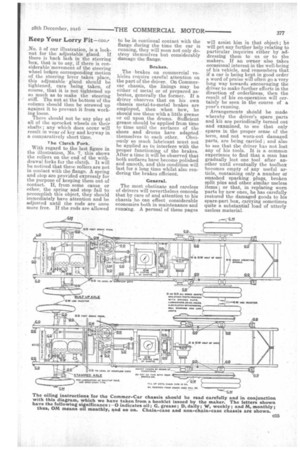How to Keep Your Lorry Fit.—XIII.
Page 5

Page 6

Page 7

If you've noticed an error in this article please click here to report it so we can fix it.
The Popular Commer Car, a Typical Chain-driven Vehicle, Forms the Subject of our Thirteenth Article.
The Commer Car has somehow ;ained the reputation of being the popular chassis. It is certain, at the very least, that these notes, con.!erning the Care of chassis emanatMg from the works of Commercial Oars, Ltd., Luton, will be as widely read as any of the series. We deal is particular with that model known is the R.C. type, which is designed o carry a net load of 3i tons, and in. ,-,hat capacity has given, and is givng, remarkably good service at the Front. We have reason for knowng that some hundreds of the type ire Overseas. They have helped in io inconsiderable degree, to remove he War Office prejudice against !hain-driven vehicles, of which the -i'ommer Car is a typical example. The design includes a four-cylinler engine, the special Commer ;earbox, and chains either open or ,nclosed in those special chain cases vhich have been so successfully lolopted by this company.
Lubrication the First Duty.
As in previous articles on the care 4 chassis, we commence by referfloe to to the very necessary feature 4 lubrication. In general, it may le remarked, the driver who is thoough and careful in his lubrication as little to fear in the way of tronile in the working of his chassis. he habits of care a-nd observation Thich will result from the systema
tie carrying out of this operation will lead him to give due attention to the other requirements in respect of upkeep of his vehicle.
The lubrication of the engine is automatic ; the crankcase merely needs filling, with a good quality engine-lubricating oil until it overflows from the petcock provided at the side of the crankcase ; this cock should be opened before replenishing the engine oil. As regards the gearbox, in some models a filler is provided in the side of the ease, which also serves as a level indicator. It is only necessary in this event to pour oil in the filling orifice until it is about to overflow. Where no fillera is provided, the case should be filled with ordinary gear oil up to the level of the gearbox shafts. The differential case should be filled with a mixture of half yellow grease and half gear oil.
Chains, Whether Open or Enclosed, Need Attention.
As to the final drive mechanism —the chains ; these should receive attention in one way or another according as to whether they are open or enclosed. In the former case, we can only repeat once more our oft-noted advice that the driver should he provided with a spare pair of chains. These chains should be changed, say, once a month, the pair not in use being meantime thoroughly brushed, cleaned with paraffin, placed in a pan containing a mixture of tallow and engine oil, the pan then being heated until the tallow becomes fluid, and until it is certain that portions of the lubricant have penetrated to all the moving parts of the chain. It should be hung up and allowed to cool, the exterior grease then being wiped off. This process leaves substantial layers of lubricant between the rollers and rivets of the chain. The need for oil or grease on the outside of the rollers is not so imperative. If the driver is, fortunately, in charge of a vehicle fitted with chain eases, it is only necessary in the first place to pour oil into this case to such a depth that the chain dips
into it, and for him occasionally to observe that through wastage this level is not reduced. In chaindriven chassis which are not fitted with chain cases, it is essential that the radius rod joints have periodical attention in regard to lubrication. These are, of course, only the orincipal moving parts. It must not be forgotten that the fan bearings, the clutch withdrawal pins snd joints, the joints in the brake Nork, the steering gear joints, and the shackle .pins are all equally in need of lubrication. The wise owner will periodically examine these parts himself and see whether oil is present on them. If they appear to be perfectly dry, they are not in their proper condition. The oil holes should not be stopped up, and oil should be present round the outside of the joints, showing that it is working from the inside outwards.
General Care of Mechanical Details.
It is generally agreed that one of the main causes of longevity locomotives is the close attention which the machinery receives at the hands of the cleaning staff. If a piece of machinery is periodically and thoroughly cleaned and oiled, the cleaner cannot fail to observe
at a very early stage any incipient deterioration, or—and this is an important point—any tendency for parts which should be firmly attached to one another to come apart or become loose. If such attention were given to every commercialmotor vehicle, not only would the time thus spent be returned with interest in respect of the actual working hours of the vehicle and the maintenance costs be at the same time reduced, but, backed by the certainty of this care and attention, makers would then be able to find a means to reduce manufacturing. costs, whilst at the same time maintaining the usefulness of their vehicles.
Where Attention is Most Needed.
There are, however, in several chassis some few points where slackness is likely to develop, in course of time, and these should be, periodically observed so as to obviate trouble from such a cause. We have selected in the case of the Commer Car seven places where these recommendations apply. In illustration on page 375 are seven drawings illustrating these parts of the mechanism. No. 1 shows the nut securing the steering lever to the sector. If any sign of looseness as between the lever and sector be perceived, the split pin securing the nut on the inner end of the lever should be removed, and the nut bt tightened up with a good long span nor and with considerable force, tin split pin then being replaced.
Radius and Stee/ing Rods.
The clamping nut on the radiu: rod, which is shown in Fig. 2, also particularly important. If i is not kept tight, wear of tin threads of the rod rapidly ensues The same remark applies to th, large locking nut on the steerim rod, which we show in Fig. 3. Th, nuts on the bolts which secure th, cap of the socket which fits on tb, end of this rod should have atten tion at the same time.
Slackness Means Wear.
With regard to the lever attache, to the steering head on the Iron axle, this, like the steering rod ii the sector already mentioned should be examined for play an the nut be tightened accordingly. this case, if the slackness is allowe, to continue, the effect will be wea of the key or its keyway—or bothwhich prevents the lever from turr ing on its own axis. In the even of such wear taking place, due t neglect of simple precautions, r( pair would prove a comparativel expensive one.
The nut which will be observe at the bottom of the steering co: umn, and which we also show i
No. 5 of our illustration, is a locknut for the adjustable gland. If there is back lash in the steering box, that is to say, if there is considerable.movement of the steering wheel beflore corresponding motion of the steering lever takes place, this adjustable gland should be tightened, care being taken, of course, that it is not tightened up so much as to make the steering stiff. The nut at the bottom of the column should then be screwed up against it to prevent it from working loose.
There should not be any play at all of the sprocket wheels on their shafts ; any which does occur will result in wear of key and keyway in a comparatively short time.
The clutch Fork.
With regard to the last figure in the illustration, No. 7, this shows the rollers on the end of the withdrawal forks for the clutch. It will be noticed that thee rollers are not in contact with the flange. A spring and stop are provided expressly for the purpose of keeping them out of contact. If, from some cause or other, the spring and stop fail to accomplish this object, they should immediately have attention and be adjusted until the rods are once more free. If the rods are allowed to be in continual contact with the flange during the time the car is running, they will soon not only destroy themselves but considerably damage the flange.
Brakes.
The -brakes on commercial vehicles require careful attention on the part of the driver. On Commercar chassis, the linings may be either of metal or of prepared asbestos, generally the former. If a driver observes that on his own chassis metal-to-metal brakes are employed, then when hew, he should use these with a little grease or oil upon the drums. 'Sufficient grease should be applied from time to time until the surfaces of the shoes and drums have adapted themselves to each other. Obviously so much lubricant must not be applied as to interfere with the proper functioning of the brakes. After a time it will be observed that both surfaces have become polished and smooth, and this condition will last for a long time whilst also rendering the brakes efficient.
General.
The most obstinate and careless of drivers will nevertheless concede that by care of and attention to his chassis he. can effect considerable economies both in maintenance and running. A perusal of these pages will assist him in that object ; he will get any further help relating to particular inquiries either by addressing them to us or to the makers. If an owner also takes occasional interest in the well-being of his vehicle, and remembers that if a car is being kept in good order a word of praise will often go a very long way towards encouraging the driver to make further efforts in the direction of orderliness, then the result of his co-operation will certainly be seen in the course of a year's running.
Arrangements should be made whereby the driver's spare parts and kit are periodically turned out and examined, to see that only spares in the proper sense of the term, and not worn-out damaged parts, are being carried ; and also to see that the driver has not lost any of his tools. It is a common experience to find that a man has gradually lost one tool after another until eventually the toolbox becomes empty of any useful article, containing only a number of smashed sparking plugs, broken split pins and other similar useless items ; or that, in replacing worn parts by new ones, he has carefully restored the damaged goods to his spare-part box, carrying sometimes quite a substantial load of utterly useless material.




















